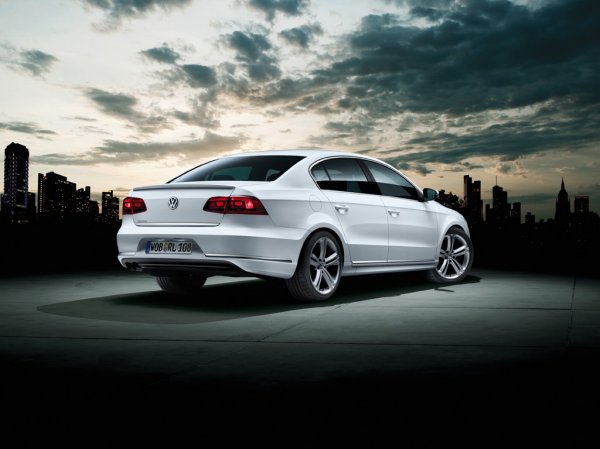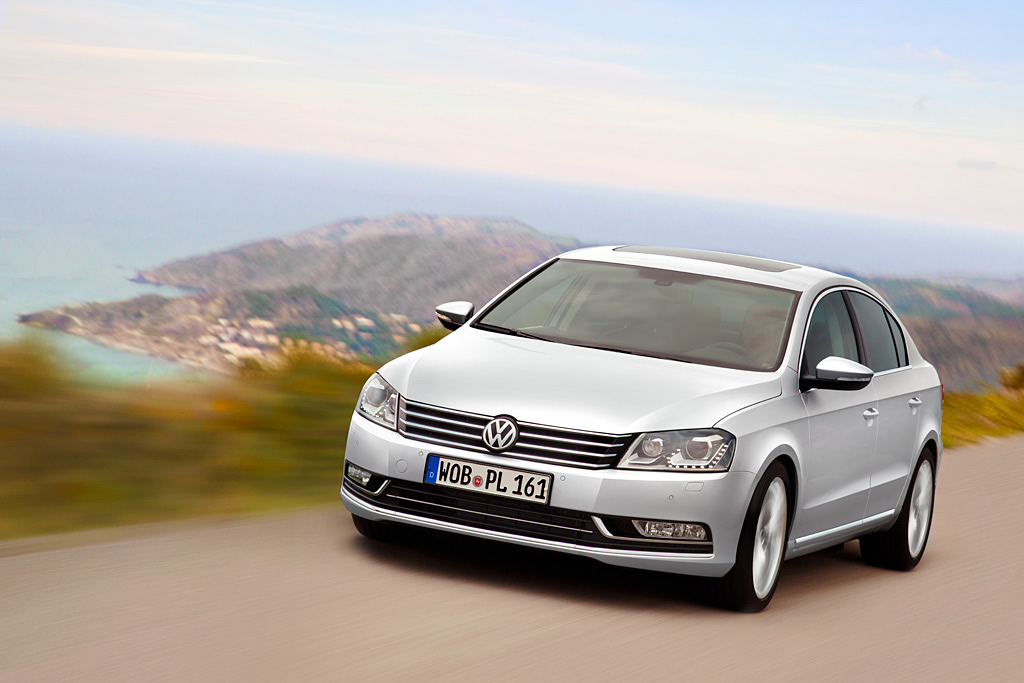2013 Volkswagen Passat 2.5L
Cars with the “VW” logo have been gracing the streets of America for over half a century. They include legendary Volkswagens such as the Beetle, Microbus, Karmann Ghia and VW Porsche 914 – all unconventional and ingeniously designed cars. Today, along with the Passat, Volkswagen offers other innovative models in the USA that include the likes of the Touareg, Tiguan, Jetta, Eos, New Beetle and CC.
The first Passats found their way to America back in 1987. Since then, over 700,000 Passats have been sold between New York and Los Angeles. Plans are in place to produce about one million new generation US Passats over the next seven years. The contrast between these two figures – 0.7 million Passats in 23 years versus 1.0 million Passats in just seven years now – makes a clear statement about the new Passat’s key role for Volkswagen of America. The company wants to triple the total annual volume of all of its USA models to about 800,000 units by 2018. Incidentally, to date over 15 million people have chosen a Passat; so this Volkswagen model series represents one of the very great successes in automotive history.
Three engines and the world’s most efficient automatic
Other decisive factors in the car’s global success are the exceptionally fuel-efficient engines and transmissions from Volkswagen. These high-tech components are found in the 2013 Passat as well. It is powered by one of three torque-strong engines, all developed in Germany.
2.5-litre five-cylinder engine with 170 PS: It all begins with a 125 kW / 170 PS (at 5,700 rpm) five-cylinder engine, which is being used for the first time in the Passat. With manual transmission, it accelerates the saloon to 60 mph in just 8.2 seconds. Volkswagen of America expects that about two-thirds of Passat customers will choose this engine, which is as torque-strong (maximum 240 Newton meters at 4,250 rpm) as it is fuel-efficient (32 mpg extra urban). As an alternative, the 2.5 MPI may be paired with a 6-speed automatic. In this case, fuel economy is 31 mpg; this automatic transmission version completes the sprint to 60 mph in 8.7 seconds.
3.6-litre six-cylinder engine with 280 PS: A masterpiece of an entirely different kind is the six-cylinder engine with 206 kW / 280 PS (at 6,200 rpm) and a maximum torque of 350 Newton meters (from 2,500 to 5,000 rpm); the 3.6-litre VR6 makes the new Passat a top-flight sports saloon that accelerates to 60 mph in just 6.5 seconds, offers luxury class driving comfort and shows European-type restraint in its fuel consumption, attaining 28 mpg (extra urban). Changing gear on this top model is handled by a standard 6-speed DSG; the dual-clutch transmission is considered the most efficient automatic in the world.
2.0-litre turbodiesel engine with 140 PS: Also very popular between New York and San Francisco are the brand’s fuel-efficient high-tech turbodiesels (TDI / Clean Diesel). They are among the cleanest diesel engines in the world, fulfilling emissions requirements for all 50 US states. In the new Passat a TDI with 103 kW / 140 PS (at 4,000 rpm) provides the driving power. Emissions control is handled by an oxidation catalytic converter, particulate filter and SCR catalytic converter. The Passat TDI’s SCR catalytic converter converts nitrogen oxides (NOx) into nitrogen and water using the additive AdBlue.
With 320 Newton meters of maximum torque (from 1,750 to 2,500 rpm), the quiet four-cylinder common rail engine is as strong as a six-cylinder petrol engine and has the fuel economy of a hybrid: 43 mpg (extra urban) and a total driving range of nearly 800 miles are the new benchmarks. The Passat TDI completes the sprint from 0 to 60 mph in 9.3 seconds. The TDI may be ordered with a 6-speed DSG as an option. Here too, the car attains 43 mpg in the extra urban cycle; with DSG, 0-60 mph acceleration is even improved to 9.1 seconds.
Visual dominance of a large saloon
It is the balanced proportions of the new Passat that give it its entirely unique, timeless and dominant styling. Just a few precise lines suffice to define its form. These style lines are reflected par excellence in the “design DNA” of the 2013 Passat: clear, minimal forms and lines with a predominance of horizontal body elements. Visually, this impressive styling launches the new Passat up half a class. The bottom line: this car looks much more expensive than it actually is.
Front end: The key identifying feature of a strong brand is in the styling of its front end. Here the Passat displays the new brand face: in keeping with the “design DNA,” horizontal elements dominate the image – the grille and headlights form a single unit. However, unlike the models of the compact class with their flatter, more flush radiator grilles, the new Passat’s grille is sculpted in a three-dimensional shape. Moreover, the grille stands more upright and makes a more distinctive and elegant impression in its stricter geometry. On the level below the painted bumper, there is another air intake that is laterally bordered by chrome-plated winglets (stylized elements similar to the wing tips of commercial aircraft). The front fog lights are integrated here. On the lowest level, there is the front spoiler. Taking cues from car racing it also features so-called splitters.
Side profile: In the sill area, a muscular seam provides for a lively interplay of light reflections. In the higher equipment line versions, the seams are framed by a narrow chrome strip that complements the chrome elements of the front and rear bumpers. At the same time, powerfully sculpted wheel arches emphasize the dynamic properties of the Passat; the smallest wheel-tire combination for the Volkswagen: 16-inch wheels with 215/60 tires. In the very beautiful balance of the side profile, the roof lines flow towards the back with a nearly coupé-like cut of the rear window. Three side windows create a long, extended glass surface in luxury class style that characterizes the car’s side appearance.
Rear section: As at the front end, the rear section is also dominated by horizontal lines. The large taillights, whose lines rise toward the sides, underscore the dynamics of the otherwise decidedly elegant rear styling. Another unique feature here is the night design of the two-part taillights (integrated into the rear bumper and boot lid).
Inside, the Passat also shows the look of considerably more expensive cars
Like the Passat’s exterior, the interior is also marked by a clean and geometric formal structure. Interior styling consistently follows the maxims of functionality. Without exception, controls are self-explanatory; every driver will be able to intuitively operate the new Passat. The instruments themselves have very clean lines, and the materials used are of high quality.
The instruments before the driver are similar to those of the Touareg; they have chrome bezels, are centrally located, and there is a digital multifunction display between the tachometer and speedometer. A high-end chrome look is also applied to the air vents in the cockpit and to the surrounds of the radio, navigation and climate control panels on the centre console. The rotary light switch and handbrake grip are also treated in chrome. Except for the base version, all other new Passats have chrome interior accents on the window lift, mirror adjustment and boot opening switches.
The upper and lower instrument areas are visually distinguished by various decorative accents, depending on the equipment version. Decorative elements in “Titan” design are used in the S versions; in the SE versions, the elegant “Titan Silver Printed” decor is used; aboard the exclusive SEL versions, it is the wood decor “Autumn Burl Brown.” The specific accents not only upgrade the instruments, but also the gearshift panel (the area between the gear lever and the front armrest) as well as the door trim panels.
The seats are exceptionally comfortable. They fit like the proverbial favourite pair of jeans. Even in the base version, the driver’s seat is height-adjustable and equipped with an adjustable lumbar support. Just like in a sports car, all controls are easy to reach – regardless of the driver’s height. This may sound banal, but it is not; it is precisely what separates the instrument layouts of vehicles that feel right and those that do not. In recent years, Volkswagen has defined its own completely new ergonomic standard, which is responsible for the brand’s enormous success globally.
All key features are standard
The Passat is available in three equipment lines S, SE and SEL. In all three lines, Volkswagen produces the Passat with line-specific features such as 16-, 17- and 18-inch alloy wheels (some as optional equipment), electric seat adjustment, mock or genuine leather seats, leather-trimmed multifunction steering wheel, Sat radio with touchscreen, “Fender” sound system, two different radio-navigation systems, front fog lights with static cornering lights, wood decor, automatic climate control, ambiance lighting and Keyless Access engine starting and locking system.
The ingenuity of the new Passat’s design is illustrated by two of its features. First feature: “Valet Parking.” If the car is to be driven by a third party, the driver simply presses the Valet Parking button in the glove compartment, removes the “Valet Parking Key” clipped inside it on the left and uses the key to lock the compartment. Now the main vehicle key can be given to the car park or hotel attendant who can then drive the vehicle but is not able to open the boot or glove compartment.
Second feature: “Remote Start.” In extreme weather conditions, the driver can start the engine (automatic or DSG transmission) by remote control (maximum ten minutes running time) to have the climate control system either cool down or heat the car’s interior to a preset temperature before driving off.
 Asian Fortune Your source for all things Asian American
Asian Fortune Your source for all things Asian American



Hi admin, i found this post on 21 spot in google’s search results.
I’m sure that your low rankings are caused by high bounce rate.
This is very important ranking factor. One of the biggest reason for high
bounce rate is due to visitors hitting the back
button. The higher your bounce rate the further down the search results your posts and pages will
end up, so having reasonably low bounce rate is important for increasing your rankings naturally.
There is very useful wordpress plugin which can help you.
Just search in google for:
Seyiny’s Bounce Plugin
I’ve read several just right stuff here. Definitely worth bookmarking for revisiting.
I wonder how a lot attempt you set to make the sort of wonderful informative website.